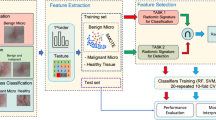Abstract
Radiologists use an “Overall impression” rating to assess a suspicious region on a mammogram. The value ranges from 1 to 5. They will definitely send a patient for biopsy if the rating is 4 or 5. They will send the patient for core biopsy when a rating of 3 (indeterminate) is given. We have developed three methods to aid diagnosis of cases with microcalcifications. The first two methods, namely, Bayesian and multiple logistic regression (with a special “cutting score” technique), utilise six parameter ratings which minimise subjectivity in characterising the microcalcifications. The third method uses three parameters (age of patient, uniformity of size of microcalcification and their distribution) in a multiple stepwise regression. For both training set and test set, all three methods are as good as the two radiologists in terms of percentages of correct classification. Therefore, all three proposed methods potentially can be used as second readers.
Similar content being viewed by others
References
Lanyi, M.,Diagnosis and Differential Diagnosis of Breast Calcifications, Springer-Verlag, 5,13, 1988.
Glasziou, P. P.,Mammographic screening in Australia, Medical Journal Australia, 167: 516–517, 1997.
Kocur, C. M., Rogers, S. K., Myers, L. R., Burns, T., Kabrisky, M., Hoffmeister, J. F., Bauer, K. W., and Steppe, S. M,Using neural networks to select wavelet features for breast cancer diagnosis, IEEE Engineering in Medicine and Biology, 95-104, 1996.
Jiang, Y.,A computer-aided diagnostic scheme for classification of clustered microcalcifications in mammograms, Medical Physics, 26(6): 1018, 1999 (Ph.D. Thesis Abstract).
Schmidt, F., Sorantin, E., Szepesvari, C., Graif, E., Becker, M., Mayer, H. and Hartwagner, K.,An automatic method for the identification and interpretation of clustered microcalcifications in mammograms, Physics in Medicine and Biology, 44: 1231–1243, 1999.
Veldkamp, W. J. H., Karssemeijer, N., Otten, J. D. M. and Hendriks, J. H. C. L.,Automated classification of clustered microcalcifications into malignant and benign types, Medical Physics, 27(11): 2600–2608, 2000.
Tourassi, G. D., Markey, M. K., Lo, J. Y. and Floyd Jr, C.E.,A neural network approach to breast cancer diagnosis as a constraint satisfaction problem, Medical Physics, 28(5): 804–811, 2001.
Schmidt, R. A. and Nishikawa, R. M.,Clinical use of digital mammography: the present and the prospects, Journal of Digital Imaging, 8(1), SUPPL 1: 74–79, 1995.
Chan, H. P., Sahiner, B., Helvie, M. A., Petrick, N., Roubidoux, M. A., Wilson, T. E., Adler, D. D., Paramagul, C., Newman, J. S. and Sanjay-Gopal, S.,Improvement of radiologists’ characterization of mammographic masses by using computer-aided diagnosis: An ROC Study, Radiology, 212: 817–827, 1999.
Shen, L., Rangayyan, R. M., and Leo Desautels, J. E., Application of shape analysis to mammographic microcalcifications, IEEE Transactions. on Medical Imaging, 13: 263–74, 1994.
Nguyen, H.,Neural Networks for Classifying Microcalcifications in Mammograms, Consulting Report to Foundation for Australian Resources, 1997.
Blinowska, A., Chatellier, G., Wojtasik, A. and Bernier, J.,Diagnostica — A Bayesian decision-aid system — applied to hypertension diagnosis, IEEE Transactions on Biomedical Engineering, 40(3): 230–235, 1993.
Bland, M.,An Introduction to Medical Statistics, Oxford University Press, 1987.
Berger, J. O.,Statistical Decision Theory and Bayesian Analysis, Springer-Verlag, 1985.
Hosmer, D. W. and Lemeshow, S.,Applied Logistic Regression, New York, Wiley Press, 1989.
Beck, J. R. and Shultz, E. K.,The use of relative operating characteristics (ROC) curves in test performance evaluation, Archives of Pathology and Laboratory Medicine, 110: 13–20, 1986.
MedCal — statistical software for biomedical research version 7.1 (http://www.medcal.be/).
Author information
Authors and Affiliations
Corresponding author
Rights and permissions
About this article
Cite this article
Hung, W.T., Nguyen, H.T., Lee, W.B. et al. Diagnostic abilities of three CAD methods for assessing microcalcifications in mammograms and an aspect of equivocal cases decisions by radiologists. Australas. Phys. Eng. Sci. Med. 26, 104–109 (2003). https://doi.org/10.1007/BF03178778
Received:
Accepted:
Issue Date:
DOI: https://doi.org/10.1007/BF03178778




